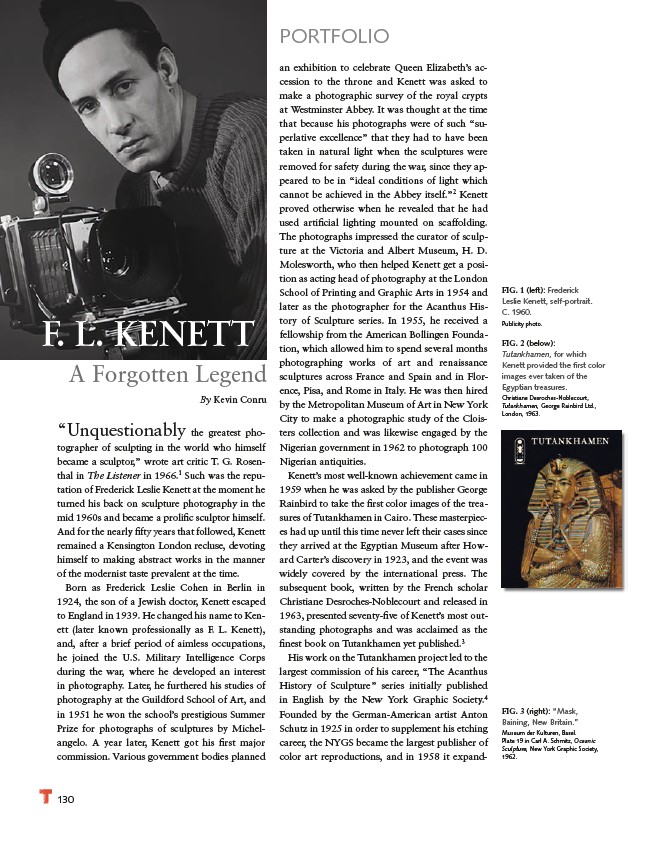
130
PORTFOLIO
F. L. KENETT
A Forgotten Legend
By Kevin Conru
“Unquestionably the greatest photographer
of sculpting in the world who himself
became a sculptor,” wrote art critic T. G. Rosenthal
in The Listener in 1966.1 Such was the reputation
of Frederick Leslie Kenett at the moment he
turned his back on sculpture photography in the
mid 1960s and became a prolifi c sculptor himself.
And for the nearly fi fty years that followed, Kenett
remained a Kensington London recluse, devoting
himself to making abstract works in the manner
of the modernist taste prevalent at the time.
Born as Frederick Leslie Cohen in Berlin in
1924, the son of a Jewish doctor, Kenett escaped
to England in 1939. He changed his name to Kenett
(later known professionally as F. L. Kenett),
and, after a brief period of aimless occupations,
he joined the U.S. Military Intelligence Corps
during the war, where he developed an interest
in photography. Later, he furthered his studies of
photography at the Guildford School of Art, and
in 1951 he won the school’s prestigious Summer
Prize for photographs of sculptures by Michelangelo.
A year later, Kenett got his fi rst major
commission. Various government bodies planned
FIG. 1 (left): Frederick
Leslie Kenett, self-portrait.
C. 1960.
Publicity photo.
FIG. 2 (below):
Tutankhamen, for which
Kenett provided the fi rst color
images ever taken of the
Egyptian treasures.
Christiane Desroches-Noblecourt,
Tutankhamen, George Rainbird Ltd.,
London, 1963.
FIG. 3 (right): “Mask,
Baining, New Britain.”
Museum der Kulturen, Basel.
Plate 19 in Carl A. Schmitz, Oceanic
Sculpture, New York Graphic Society,
1962.
an exhibition to celebrate Queen Elizabeth’s accession
to the throne and Kenett was asked to
make a photographic survey of the royal crypts
at Westminster Abbey. It was thought at the time
that because his photographs were of such “superlative
excellence” that they had to have been
taken in natural light when the sculptures were
removed for safety during the war, since they appeared
to be in “ideal conditions of light which
cannot be achieved in the Abbey itself.”2 Kenett
proved otherwise when he revealed that he had
used artifi cial lighting mounted on scaffolding.
The photographs impressed the curator of sculpture
at the Victoria and Albert Museum, H. D.
Molesworth, who then helped Kenett get a position
as acting head of photography at the London
School of Printing and Graphic Arts in 1954 and
later as the photographer for the Acanthus History
of Sculpture series. In 1955, he received a
fellowship from the American Bollingen Foundation,
which allowed him to spend several months
photographing works of art and renaissance
sculptures across France and Spain and in Florence,
Pisa, and Rome in Italy. He was then hired
by the Metropolitan Museum of Art in New York
City to make a photographic study of the Cloisters
collection and was likewise engaged by the
Nigerian government in 1962 to photograph 100
Nigerian antiquities.
Kenett’s most well-known achievement came in
1959 when he was asked by the publisher George
Rainbird to take the fi rst color images of the treasures
of Tutankhamen in Cairo. These masterpieces
had up until this time never left their cases since
they arrived at the Egyptian Museum after Howard
Carter’s discovery in 1923, and the event was
widely covered by the international press. The
subsequent book, written by the French scholar
Christiane Desroches-Noblecourt and released in
1963, presented seventy-fi ve of Kenett’s most outstanding
photographs and was acclaimed as the
fi nest book on Tutankhamen yet published.3
His work on the Tutankhamen project led to the
largest commission of his career, “The Acanthus
History of Sculpture” series initially published
in English by the New York Graphic Society.4
Founded by the German-American artist Anton
Schutz in 1925 in order to supplement his etching
career, the NYGS became the largest publisher of
color art reproductions, and in 1958 it expand-